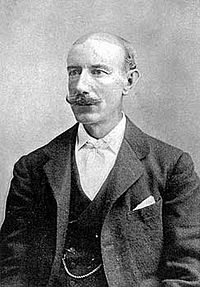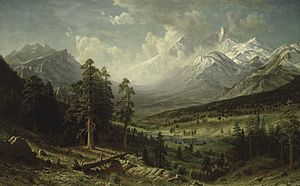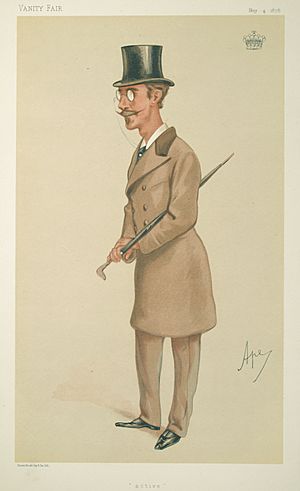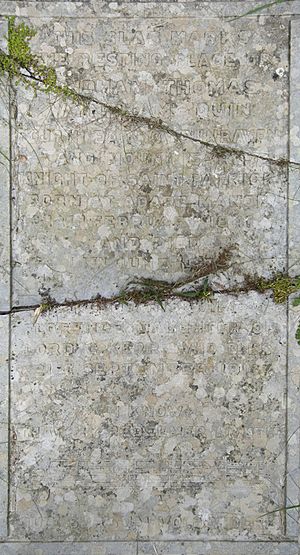Windham Wyndham-Quin, 4th Earl of Dunraven and Mount-Earl facts for kids
Quick facts for kids
The Earl of Dunraven
and Mount-Earl KP PC
|
|
|---|---|

Lord Dunraven and Mount-Earl.
|
|
| Under-Secretary of State for the Colonies | |
| In office 24 June 1885 – 28 January 1886 |
|
| Monarch | Victoria |
| Prime Minister | The Marquess of Salisbury |
| Preceded by | Evelyn Ashley |
| Succeeded by | George Osborne Morgan |
| In office 3 August 1886 – 16 February 1887 |
|
| Monarch | Victoria |
| Prime Minister | The Marquess of Salisbury |
| Preceded by | George Osborne Morgan |
| Succeeded by | The Earl of Onslow |
| Personal details | |
| Born | 12 February 1841 |
| Died | 14 June 1926 (aged 85) |
| Nationality | British |
| Political party | Conservative |
| Spouse | Florence Kerr |
| Alma mater | Christ Church, Oxford |
Windham Thomas Wyndham-Quin, the 4th Earl of Dunraven and Mount-Earl (born February 12, 1841 – died June 14, 1926), was an important figure in British and Irish history. He was known as Viscount Adare until 1871. He was a journalist, a landowner, a businessman, and a sportsman. He also served as a Conservative politician.
Lord Dunraven worked as an Under-Secretary of State for the Colonies. This meant he helped manage parts of the British Empire. He held this role twice, from 1885 to 1886 and again from 1886 to 1887. He also played a key role in the 1902 Land Conference, which helped solve land issues in Ireland. He founded the Irish Reform Association. During the Boer War, he even raised and led two groups of skilled shooters.
He was also a big game hunter. In 1874, he tried to create a large game park in Colorado, United States. He built a hotel there for tourists. However, he later sold the land because many settlers wanted to live there.
Contents
Who Was Lord Dunraven?
Windham Thomas Wyndham-Quin was a very active person. He had many different jobs and interests throughout his life. He was born into a noble family in Ireland. He became a well-known journalist, reporting from war zones. He also served in the military and was involved in politics.
Early Life and Education
Lord Dunraven was the son of the 3rd Earl of Dunraven and Mount-Earl. His mother was Florence Augusta Goold. He went to Christ Church, Oxford, a famous university. After college, he joined the 1st Life Guards, a cavalry regiment, as a lieutenant.
A Reporter's Adventures
At 26, Dunraven became a war correspondent. This meant he reported on wars for a newspaper. He worked for The Daily Telegraph in London. He covered the Abyssinian War in Africa. During this time, he shared a tent with Henry Morton Stanley, another famous reporter.
He also reported on the Franco-Prussian War in 1870–71. He saw the Siege of Paris. He also reported on wars in Spain and Turkey. He was present when the Treaty of Versailles was signed in 1871. This treaty ended the Franco-Prussian War. Later, he also saw the signing of the Treaty of Versailles in 1919, which ended World War I.
Military Service
Lord Dunraven had a long military career. He started as an ensign in the Oxford University Rifle Volunteer Corps in 1859. He was promoted to lieutenant in 1860. He later joined the 1st Life Guards as a cornet and sub-lieutenant in 1865. He even bought his promotion to lieutenant, which was common then.
He served as an extra Aide-de-Camp to the Lord Lieutenant of Ireland in 1864. He retired from the 1st Guards in 1867. He also held honorary colonel positions in different military units. These included the Glamorgan Artillery and the 5th Battalion, the Royal Munster Fusiliers.
The Sharpshooters in the Boer War
During the South African War (1899-1902), the British Army faced tough challenges. The Boer fighters were excellent shots and horsemen. This led many people in the United Kingdom to volunteer for service. Lord Dunraven created a committee in December 1899. Their goal was to find volunteers who were good at both riding and shooting.
By March 1900, they had formed a full battalion called the 18th Battalion Imperial Yeomanry. Lord Dunraven decided to join them. He was made a supernumerary captain. He was even mentioned in official reports by Lord Roberts, a top commander.
In 1901, the government asked for more volunteers. Lord Dunraven's committee recruited another 1,200 men. These men formed two more battalions, the 21st and 23rd Sharpshooters. These groups were very successful in fighting the Boers. They showed how valuable mobile, well-armed troops could be.
Because of their success, Lord Dunraven was allowed to create a regiment for service in Britain. This was the 3rd County of London (Sharpshooters) Imperial Yeomanry. For his service in South Africa, he was awarded the Companion of the Order of Saint Michael and Saint George (CMG) in 1902.
Political Work
When his father died in 1871, Dunraven became the Earl and took his seat in the House of Lords. He served as Under-Secretary of State for the Colonies twice. This role involved helping the Prime Minister, Lord Salisbury, manage British colonies.
From 1888 to 1890, he led a group looking into "Sweated Labour." This was about poor working conditions and low pay. As a moderate Unionist, he wanted to find peaceful solutions for Ireland. He aimed to solve the "Irish land question" and the demand for Home Rule. Home Rule meant Ireland would have more control over its own affairs.
Helping Irish Landowners and Tenants
Lord Dunraven owned a large estate called Adare Manor in County Limerick, Ireland. He played a key role in the 1902 Land Conference. He was the chairman and represented the landowners. Working with William O'Brien, who represented the tenants, they created a report.
This report led to the Land Purchase (Ireland) Act 1903. This law helped tenants buy land from their landlords. It made it easier for them to own their own farms. This act was a big step in ending absentee landlordism in Ireland.
Ideas for Irish Self-Government
After the Land Conference, Lord Dunraven started the Irish Reform Association. This group wanted to apply the "conference policy" to other areas of Irish life. In 1904, they suggested a plan called "devolution." This meant giving Ireland limited powers to govern itself locally.
This idea was seen as a step towards self-government. However, it did not get enough support from Irish nationalists. They felt it was not enough. Unionists, especially in Ulster, worried it was a trick to get full Home Rule. This disagreement caused a lot of debate.
Dunraven was also a member of the Order of Saint Patrick. When the Irish Free State was formed, he became a member of its first Senate in 1922. He served there until 1926. He was chosen to ensure that unionists in southern Ireland had a voice in the new government.
Adventures in Colorado
Lord Dunraven loved hunting wild animals around the world. He heard about the great hunting in the American West. He first visited in 1872. There, he met Texas Jack Omohundro, who became his guide. Texas Jack led him on buffalo and elk hunts.
In 1874, Dunraven returned to the American West. He explored Yellowstone Park with Texas Jack. He wrote a book about this trip called Hunting in the Yellowstone. Later, he decided to turn all of Estes Park, Colorado into his own private hunting area. He claimed 15,000 acres of land. This area is now part of Rocky Mountain National Park.
His actions were seen as a huge land grab. More settlers arrived in 1874 and 1875. Their arrival stopped him from taking over all the land.
Building a Tourist Hotel
In 1876, Dunraven asked artist Albert Bierstadt to paint a picture of Longs Peak and Estes Park. He paid $15,000 for it. This painting was meant for his castle. Bierstadt also helped Dunraven choose a spot for his "English Hotel."
The hotel was built in 1877. It was the first hotel built specifically for tourists in Estes Park. It was a three-story wooden building. Even though the hotel was successful, Dunraven became disappointed. He left the area for good in the late 1880s.
Dunraven realized he couldn't control the whole park. In 1907, he sold his property. F. O. Stanley later built the famous Stanley Hotel in Estes Park. Dunraven's original "English Hotel" burned down in 1911.
A Passion for Sports
Lord Dunraven was very interested in sports. He had a stud farm for horses at his Adare Manor estate. He also tried growing tobacco. He was a very keen yachtsman. He owned or co-owned the yachts Valkyrie II and Valkyrie III. These yachts competed in the America's Cup races in 1893 and 1895.
After returning from a race in 1896, Dunraven claimed that the winning American yacht, Defender, had cheated. As a sportsman, he also wrote a book called Canadian Nights. This book was about "life and sports in the Rockies."
Family and Legacy
Lord Dunraven married Florence Kerr. They had three daughters:
- Lady Florence Enid Wyndham-Quin (1870–1891)
- Lady Rachael Charlotte Wyndham-Quin (1872–1901)
- Lady Aileen May Wyndham-Quin (1873–1962)
From 1900 onwards, Lord Dunraven developed the gardens on Garinish Island in Ireland. He had inherited the island from his father. He turned it into a beautiful subtropical wild garden, which still exists today. The house on the island was burned during the Irish Civil War in 1922 but was later rebuilt.
Lord Dunraven passed away in June 1926 at the age of 85. He did not have any sons, so his title, the earldom, went to his cousin. He left his personal property, including Garinish Island, to his only surviving daughter, Aileen. His family estates, like Adare Manor, went to his cousin who inherited the title. He was buried in Adare, County Limerick, Ireland.
In 1939, a street in London, Norfolk Street, was renamed Dunraven Street in his honor. Dunraven Pass and Dunraven Peak in Yellowstone National Park are also named after him.





